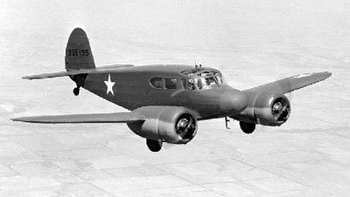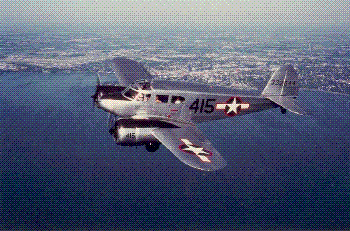UC-78 Bobcat
The Cessna UC-78 was known by many names/designations: AT-17, T-50, Bobcat, Twin Breasted Cub, Useless 78, and Bamboo Bomber. The UC-78 is a fabric covered, wood winged, twin engine trainer and transport used in all theaters of World War II. The fuselage is wood formers over a steel tube structure and the wings, tail structures and control surfaces area are all wood. The entire wing is made as a single wing with a full length 42 foot laminated spar. The steel tube fuselage sits over and bolts onto the wing. It carries a crew of two with seating for three passengers sitting side by side in a cavernous interior. The original airplane was powered by two Jacobs L4MB engines rated at 245 horsepower each. The UC-78 was converted to the more powerful Lycoming R-680-13 engines rated at 300 horsepower each in 1952. The propellers are Hamilton Standard 2B20 constant speed NON FEATHERING units. Cruise speed is 155 mph indicated airspeed and landing speed is 90 mph indicated airspeed. The tail wheel is not steerable which makes ground handling a real adventure, especially in crosswinds. It uses 30 gallons of fuel per hour and carries 150 gallons giving it a range of about 600 miles.
History
The first prototype, NX20784, was flown March 26, 1939 by Dwayne Wallace, president of Cessna Aircraft Company. The original civilian model was the T-50. The first military version was the AT-78 while later military versions were the AT-17, C-78, and UC-78 for the Army Air Corps. The Navy version was the JRC-1 and the Royal Canadian Air Force (RCAF) versions were the CRANE-I and CRANE-II. Of the 5,400 airplanes built during the war, only about 42 airframes remain with about half that actively flying.
Only 40 airplanes had been built when Cessna landed a contract with the RCAF to build the airplane as the CRANE-I. The first model built for the USAAF was the AT-8 with Lycoming R-680 engines, Hamilton Standard props and a Sperry Autopilot. The contracts that followed were for the AT-17, C-78 and UC-78 models with the Jacobs engines with either the wooden fixed pitch propellers or metal Hamilton Standard constant speed propellers. These aircraft were used mostly to train bomber and transport pilots on how to fly multiengine airplanes as well as navigation and formation flying. After completing advanced training in this aircraft, these new pilots were awarded their wings and transferred to bomber and transport squadrons for transition to C-47's, B-25's, B-17's, B-24's, etc. The aircraft was widely used by Allied Air Forces to haul light cargo and as a personnel transport in WWII. At the end of the war, most were offered for sale as surplus with prices ranging from $1,500 to $3,000 based on condition and engine times.
The "Bobcat" became popularized in the 1950's television series "SKYKING". The "Bobcat" was the first "SONGBIRD" in the early shows.
Restoration of AAF s/n 43-32644
This UC-78, AAF s/n 43-32644, was built in October 1943 and delivered to the Army Air Force at Pampa, Texas on January 8, 1944. It was used to train cadets at Pampa until 1945 with it was sold as surplus at the end of the war for $2,300.
Larry Kelley acquired s/n 43-32644 when it was sitting in an open field next to the Cambridge Airport, Maryland, where it had been for years. The cowlings, props, control surfaces, fairings and tail structures were missing. The fabric covering was rotten and filled with holes and tears where families of birds and field mice made homes. The entire wing structure was filled with the straw of dozens of bird nests. The wooden flooring in the cockpit would not support a man's weight. A small tree was growing up through the rear of the fuselage. Many people thought that Larry (a pharmacist by trade) must have been "sampling" some of his medicines to even consider restoring such a derelict.
The aircraft was moved indoors and a search began for craftsmen who could restore this unique old airplane. Larry asked an old friend, Paul Burkey, if he would help him restore this derelict. Paul came to the project with a unique background that made him perfect for the job. Paul joined the Army Air Corps at the outbreak of World War II. He was trained as an aircraft mechanic where he worked on almost every airplane in the Army Air Corp inventory including the UC-78. His Air Force career continued into the Korean conflict where he worked on the F-82 and F-84. At one time, he and his crew held the record for an engine change on the F-84: 30 minutes. When Paul retired from the Air Force, he took a position as a professor in the Aviation Technology Department at Southern Illinois University. At the time Larry called Paul, he and his wife were retired in Richmond, Virginia. Paul and his wife moved their motor home from Richmond to Cambridge to accept the challenge of the restoration. He began a three year restoration. Larry spent hundreds of hours on the telephone trying to locate parts while Paul began the restoration. After three years and nearly 10,000 hours of labor from a growing team of workers, the aircraft was completely restored. So much so, that it won BEST TRANSPORT at Sun-n-Fun and Oshkosh, Wisconsin EAA AirVenture in 1990. This UC-78 has been featured in Warbirds Magazine, Cessna Owners magazine, Warbirds Worldwide magazine, Wide World of Flying magazine and many other publications. At present, it is going through a rerestoration to repair and replace several items.



